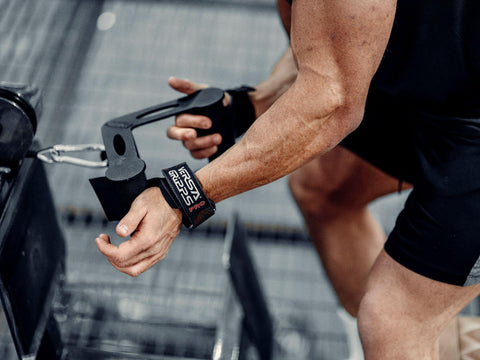
Weightlifting and Sleep Quality: How Strength Training Can Improve Sleep

Strength training (also called resistance training) not only helps you build muscle but may also be a way to improve sleep naturally.
Weightlifting and resistance training using your own body weight are particularly helpful for improving sleep—possibly even more so than aerobic exercise, according to one study.
Preliminary research from the study found that people who did resistance training for a year slept 40 minutes more on average each night. They also woke up fewer times during the night.
Waking up for just 5 or 10 minutes at a time can disrupt sleep cycles, reducing your overall sleep quality. If strength training can help you fall asleep—and stay asleep—it’s worth a closer look.
Keep reading to learn more about how strength training can improve sleep quality, why you should include resistance training in your exercise regimen, and how weightlifting grips can improve your performance.
Why does strength training improve sleep?
Researchers aren’t exactly sure why weightlifting and other forms of resistance training might be better at improving sleep than cardio exercise alone.
One theory is that weight training boosts levels of testosterone and growth hormone, which have been linked to deeper sleep.
It’s also possible that microscopic muscle tears that occur with weight training (and are completely normal) signal the brain to trigger deeper sleep, which is more restorative.
What counts as “resistance” training?

There’s no argument that resistance training has many benefits. But what is it, exactly?
Resistance training, also known as strength training, is any exercise that causes your muscles to contract against outside resistance.
Weightlifting—either with free weights or weight machines—is one type of strength training. Chest presses, bicep curls, and deadlifts are examples of weightlifting moves.
Tip: To get a better grip on your weights and lift more, invest in a pair of quality weightlifting grips, like Versa Gripps. Lifting grips boost your mind-muscle connection by helping you focus on your form—not your grip.
You can also use the weight of your own body to do strength training. For example, lunges, squats, chair dips, and push-ups are all resistance exercises that use only your body weight.
A combination of strength training a few times a week and aerobic exercise like running, brisk walking, or cycling 5-7 days a week is the key to staying healthy and fit.
If you have sleep problems—whether you struggle to get enough sleep or have trouble falling or staying asleep—you should make a conscious effort to do even more strength training each week.
10 Strength Training Moves to Try
While cardio is great for your heart and lungs, nothing is better for building muscle than strength training. Here are 10 moves to try.
Squats: This classic move targets your quadriceps, hamstrings, and glutes. With a barbell resting on your shoulders, lower your body into a squat position by bending your knees and hips, then return to the standing position. Keep your knees above—not in front of—your ankles as you squat.
Russian twists: This move targets your obliques and core muscles. Sitting on the ground with knees bent, lift your feet slightly off the floor. Hold a weight plate or medicine ball in front of your chest, then touch the weight to the floor on either side of you, rotating your torso from side to side as you go back and forth.
Bench presses: Lie on a flat bench with a barbell above your chest. Lower the barbell to your chest, then push it back up. This move targets your chest muscles, shoulders, and triceps.
Bent-over rows: Holding a barbell with an overhand grip, hinge at your hips and bend your knees slightly, then pull the barbell towards your lower chest. With good form, this move should engage your back muscles, especially the lats and rhomboids.
Overhead presses: With a barbell held at shoulder height, press it overhead until your arms are fully extended. Focus on engaging your shoulder muscles, especially your deltoids and triceps. Use Versa Gripps to help you get a better grip on your weights during overhead presses.

Lunges: Holding a pair of dumbbells at your sides, step forward with one leg and lower your body until both knees are bent at 90-degree angles, then push back to the starting position. Keep your quadriceps, hamstrings, and glutes engaged while doing lunges.
Romanian deadlifts: Holding a barbell with an overhand grip, hinge at your hips and lower the barbell towards the ground while keeping your legs straight but not locked. Return to the standing position while squeezing your glutes and hamstrings.
Pull-ups: Hang from a pull-up bar with your hands slightly wider than shoulder-width apart, then pull your body up until your chin clears the bar. This move targets your back and arm muscles, primarily the lats and biceps. Use Versa Gripps to get a better hold of the bar during pull-ups.
Push-ups: Start in a plank position with your hands slightly wider than shoulder-width apart. Keeping your core tight, lower your body until your chest nearly touches the ground, then push back up to the starting position. If you can’t lower all the way down to the ground from a plank position, try modified push-ups.
Farmer’s Walk: Hold a heavy pair of dumbbells or kettlebells at your sides and walk for a set distance or time. Focus on maintaining an upright posture. Engage your core and leg muscles for stability and strength. Use weightlifting grips to help you get a better grip on your weights.
Train Better with Versa Gripps

The benefits of strength exercise for better sleep are clear. Whether you’re new to strength training or an experienced weightlifter, Versa Gripps can improve your performance.
Designed with proprietary non-slip material, Versa Gripps help you get a better grip on your weights. This boosts your mind-muscle connection by putting the focus on your form. When you’re not worried about dropping your weights, you can concentrate on your target muscles. This can lead to bigger gains over time.
Versa Gripps are designed for weightlifters of all skill levels and abilities. They feature built-in arch support and a quick-release safety feature to help you lift safely. They’re the only grip you’ll ever need. Find your perfect pair of Versa Gripps and start training better.